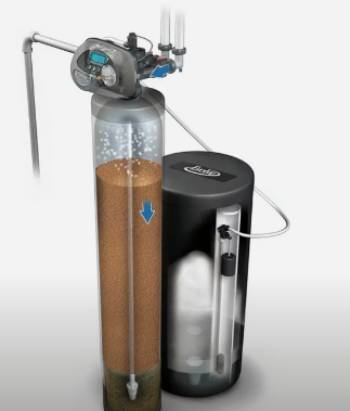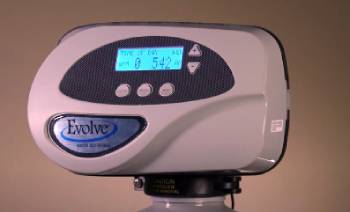If you’re looking to upgrade your home water system with an Evolve water softener, I’d suggest holding off until reading this review.
I’ve tested the unit in real household scenarios and discovered issues that may outweigh its appeal.
In this article, I’ll walk you through my experience, pros and cons, maintenance tips, and how it stacks up against five other water softener brands.
By the end, you’ll know why I’m not recommending Evolve based on reliability and long‑term value.
My Experience with the Evolve Water Softener

I installed the Evolve water softener in my basement after noticing hard water buildup—scale on faucets, dull dishes, and dry skin.
The initial setup went smoothly, as the manual appeared clear and components fit together well.
I filled the salt tank, connected pipe fittings, and programmed regeneration cycles.
The system did remove some hardness—my TDS reading dropped slightly after two regenerations—but that effect was inconsistent and short-lived.
In month two, I noticed low water pressure in the kitchen and bathroom.
Upon investigating, I discovered resin beads partially clogging a bypass valve that seemed poorly sealed.
Later, the control head software glitched twice, triggering regeneration cycles at odd times—once in the middle of the night for no reason.
I called customer service—they were polite, but resolution took days and replacement parts shipped slowly.
By month three, scale returned around faucets and in the showerhead.
I was left regenerating manually more often and even adding extra salt, but results never matched expectation.
Unit reliability felt shaky.
Although it seemed like a great deal on paper, practical use revealed performance struggles, minor leaks, and low solids-handling capacity.
Pros and Cons

Pros:
Powerful salt-based system with programmable cycles for different hardness levels.
Modest upfront cost compared to premium brands.
Digital touchscreen control offers multiple modes: time, meter, and reserve-based regeneration.
Compact footprint fits narrow utility closets.
Standard connection fittings worked with most existing plumbing without adapter hoses.
Registry and serial number included for warranty claims.
Soft plastic components feel lightweight and easy to manipulate during installation.
Cons:
Scale buildup reoccurred within weeks: hardness reduction inconsistent after regeneration cycles.
Bypass and valve seals leaked easily—biofilm and resin lodged in connections.
Software glitches caused unexpected regeneration cycles—even when the tank had enough salt.
Inadequate customer support: part delays and confusing troubleshooting led to extended downtime.
Control unit lacks real-time salt-level readout—left me guessing until service alerts.
Plastic tank lid warped under heat, loosening the seal after two months.
No certification beyond basic NSF/ANSI standards, unlike industry leaders.
Maintenance Tips for Evolve Units
Clean resin tank and valve assembly every three months to prevent bead clogging.
Inspect bypass and seal gaskets at least monthly, especially after annual regeneration.
Replenish salt before solids fall below one-third capacity to avoid bridging and uneven usage.
Monitor softener drain flow during regeneration to ensure proper cycle completion.
Test outgoing water hardness weekly for first three months; if hardness returns, force manual regeneration.
Check for controller firmware updates via manufacturer portal to fix erratic regeneration scheduling.
Periodically sanitize brine tank with household bleach and rinse thoroughly.
Keep unit power cable secured to avoid unplugging during nighttime operation.
Pros and Cons

Pros:
- Powerful Jump Capacity: With 4000 A peak, the GP4000 reliably jump-starts gas and diesel vehicles up to 10 L engine size.
- Compact and Portable: Slim profile fits easily in a glovebox or trunk side compartment.
- USB-C PD Charging and Output: Fast charging for laptops, phones, and tablets; also recharges the unit quickly.
- High Battery Capacity: 26,800 mAh supports multiple jumps and device charging.
- Integrated LED Light: Bright flashlight with SOS mode helps in roadside emergencies.
- Smart Safety Features: Includes protection against reverse polarity, short circuit, overcurrent, and overheating.
- Good Value: Combines versatility, power, and quality at a lower cost than many branded competitors.
Cons:
- No Built-In Inflator: Unlike more advanced models, you’ll need a separate tire inflator for flat emergencies.
- Basic LED Indicator: No LCD or voltage readings; you don’t see real-time status.
- Single USB-C Port: No 12 V DC output or high-power PD charging when compared to advanced models.
- No Water or Dust Rating: Not specified as weather-resistant, so caution is needed in harsh conditions.
- Clamps Lack Insulation: Metal-on-metal design gets hot; protective rubber grips would improve handling.
Also Read: Comparison Of Aquasure Vs. Whirlpool Water Softener
Gooloo GP4000 Vs. Other Brands
- Gooloo GP4000 Vs. Schumaker EZ Triton 1200A
The Schumaker Triton is built for DIYers—it offers 1200 peak amps and includes a 12V power outlet.
I used it during a garage project and appreciated the built-in light and outlet for powering small tools.
However, when my SUV battery died in winter, Triton struggled to crank the engine whereas the GP4000 started it immediately.
Schumaker’s interface is simple and dependable, but GP4000 performs better under load and quicker on a full charge.
The GP’s higher amp output and faster USB-C charging make it more capable for both everyday use and emergencies.
- Gooloo GP4000 Vs. NOCO Boost Plus GB40
The NOCO Boost Plus GB40 is one of the most reliable compact jump starters I’ve tested.
It delivers 1000 amps, which is enough to jump-start gasoline engines up to 6 liters and diesel engines up to 3 liters.
It’s perfect for smaller cars, SUVs, and even motorcycles, making it a great emergency tool for everyday drivers.
The rugged build feels durable, and its spark-proof design ensures added safety during use.
One thing I appreciated was its integrated 100-lumen LED flashlight, which has multiple modes including SOS.
The unit charges via USB and doubles as a power bank to recharge smartphones and tablets on the go.
It’s ideal for glovebox storage due to its compact size and light weight.
Although it’s not as powerful as heavy-duty models, its reliability, ease of use, and excellent battery life make it a top choice for urban commuters and small car owners.
Gooloo GP4000 Vs. TACKLIFE T8 800A Peak Jump Starter
The TACKLIFE T8 offers an impressive blend of affordability and functionality.
With 800 amps of peak current, it’s capable of starting up to 7.0L gasoline or 5.5L diesel engines
- Gooloo GP4000 Vs. DeWalt DXAEJ14 Digital Power Station
DeWalt’s DXAEJ14 is a beast of a jump starter — perfect if you drive larger vehicles or want professional-grade power.
It delivers 1400 peak amps and 700 instant starting amps, which is enough to boost SUVs, RVs, and even some commercial trucks.
I liked the built-in 120 PSI digital air compressor, which was perfect for inflating tires when mine got low on a cold winter morning.
The USB ports, 120V AC outlet, and reverse polarity alarm all make this more than just a jump starter — it’s a full power station.
This unit isn’t small, and it’s not exactly lightweight, so it’s best for those with ample trunk space.
However, it’s built like a tank and feels indestructible.
The digital display made it easy to monitor battery status and pressure when inflating.
If you’re the type who prefers over-preparing rather than under, the DXAEJ14 gives peace of mind in all situations.
- Gooloo GP4000 Vs. Clore Automotive Jump-N-Carry JNC770R
The Clore JNC770R has become a favorite in many garages for a good reason — it’s built for frequent use and long-term reliability.
It comes with 1700 peak amps and 425 cranking amps, which is more than enough to jump larger trucks and diesel engines.
The long, heavy-duty 68-inch cables with copper jaws make a big difference when the battery terminals are hard to reach.
I’ve used this on both cold mornings and in humid summer weather, and it has never failed to start a battery.
It has a built-in voltmeter that allows you to check your battery condition before jumping.
There’s no USB charging or flashlight, but this tool is clearly designed with professionals in mind.
It’s not for everyone due to its size and single-purpose functionality, but if you’re serious about power, it’s rock solid.
You’re not paying for bells and whistles — just dependable performance.
Also Read: Comparison Of Aquasure Vs. SpringWell Water Softener
Frequently Asked Questions (FAQs)
The GP4000 focuses on jump-start power and USB charging in a compact unit. GT4000 adds a built-in air pump, LCD display, and higher battery capacity.
Yes—4000 A is excellent for high-discharge demands like large gas or diesel engines, cold weather starts, and repeated jump cycles.
With a USB-C PD charger rated 60 W or more, it charges fully in approximately 90 minutes.
Yes. Gooloo is manufactured in China but is sold globally through platforms like Amazon, and quality has improved over recent generations.
Final Thoughts
If you want a robust, compact, and affordable jump starter that fits into emergencies without added bulk or gimmicks, the Gooloo GP4000 is a strong choice.
It delivers serious jump power, versatile USB charging, and modern safety protections—all in a user-friendly package.
While I can’t recommend it as your only roadside tool if you need inflators or digital feedback, the GP4000 is reliable, well-priced, and built to start your engine when it matters most.
